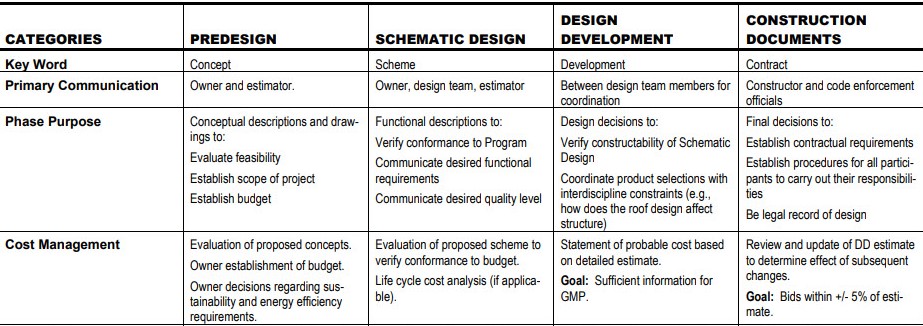2 min read
Using Information to Plan Production of Drawing and Specifications
Louis Medcalf, FCSI, CCS
2/21/20 12:30 PM

It is ironic that architects write Division 01 requirements for detailed construction activity schedules but when it comes to their design work, the schedules consist only of a list of dates for deliverables instead of activity planning. Construction activities have a structure based on sequence of construction. Is it possible to organize production of drawings and specifications in a similar manner?
The primary activity for planning a design project is making design decisions, which are then recorded as drawings or specifications for communication with the owner and construction team. Design decision management is therefore critical to producing the information needed by the construction team for accurate pricing and for construction. A starting point is to identify the categories of information that each of the design phases should provide: conceptual design, schematic design, design developments, and construction documents.
Although these phases have been used by architects for decades, there is no industry standard definition for each of the phases sufficient for planning what information is needed in each phase. The definitions in the AIA Handbook of Professional Practice are generic because they have to fit projects in size from a suburban bank to a hospital or airport terminal. When I was working at a large architectural firm some 15 years ago, I worked with a certified construction cost estimator, a code enforcement official, and others to develop a matrix of project decisions by phase to define what types of information each phase should have.
The layout of the matrix is set up with columns for the phases, and rows includes categories for phase purpose, cost management, consultants, zoning code information, building code information, energy code information, accessibility and other regulatory requirements, and construction information for architecture and engineering disciplines. The matrix also has rows for where decisions should be documented: drawings, schedules, specifications, and for QA/QC reviews. Check out the matrix here.
By defining each phase in more detail, the architects have an objective, written plan for developing specific phase goals for the project. There may be times when specific project circumstances require some decisions to be made earlier or later, but it functions as a checklist for planning and evaluating production. Such a matrix can be modified for different types of projects as appropriate or for individual office practice.
In conjunction with the planning matrix, major projects can have a Schematic Design project description organized with Uniformat, as discussed here on this website. Use of an industry standard document like Uniformat is, in effect, using a checklist to help ensure nothing is overlooked.
We all know that procrastination of research and decisions often negatively affects other design disciplines by requiring re-design. Too many projects have “value engineering” during the construction documents phase to bring the cost back into budget and that often involve project delays. This is a very frustrating and costly experience for all stakeholders: owner, design team, and construction team. Planning that manages design decisions so they are made at the appropriate time, can avoid such frustration.
Elsewhere on this web site we introduce Conspectus Cloud, a software tool for transparent collaboration in managing design decisions.
